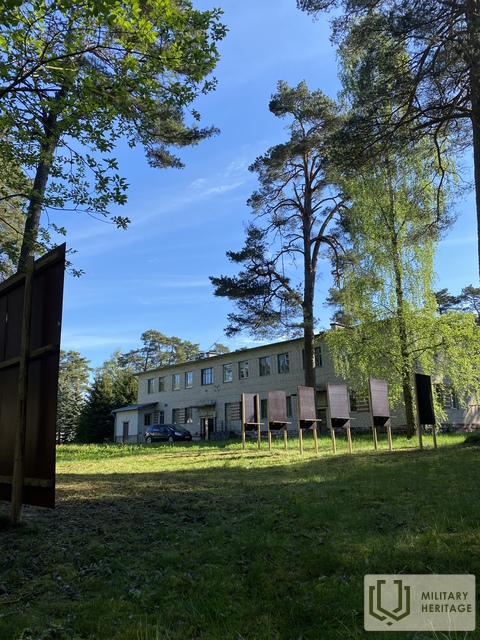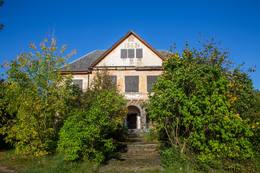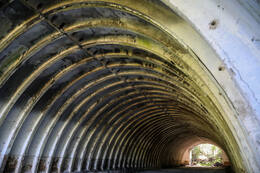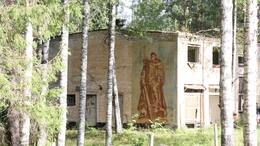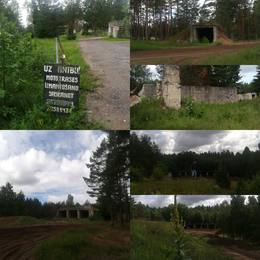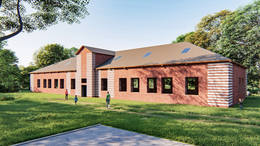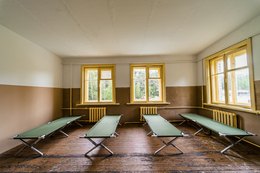Garnison
I Erster Weltkrieg, I Die Unabhängigkeitskriege, II Zweiter Weltkrieg, IV Sowjetische Okkupation
Eine Garnison ist ein Gebiet, das ein oder mehrere angrenzende Verwaltungsgebiete (Siedlungen) umfassen kann, die eine militärische, wirtschaftliche, kulturelle oder andere Rolle für den Betrieb von Militäreinheiten haben.
Der Garnisonskommandeur ist für die erforderliche Anzahl von Garnisonseinheiten und deren Gebiet verantwortlich.
Zugehörige Objekte
Adam-Steel-Schule
Das Schulgebäude im Stadtzentrum befindet sich auf der linken Seite der Ausekļa-Straße neben dem Valka-Jānis-Cimze-Gymnasium.
Das nach dem Lehrer Adam Steel benannte Gebäude beherbergte ursprünglich die Schule und wurde 1923 fertiggestellt. 1946 befand sich hier das militärische Hauptquartier der Armeegarnison. So wurde im Zentrum von Valka ein Militärzentrum eingerichtet, und Valka wurde zu einer wichtigen Atomwaffenanlage für die Armee der UdSSR. Das Territorium des Gebäudes war von einem hohen Zaun umgeben und wurde Stadt in der Stadt genannt, weil es dort ein eigenes Geschäft, ein Krankenhaus, ein Kesselhaus und sogar ein Café für die Bedürfnisse der Armee gab. Auf dem Dachteil des Gebäudes wurde das Symbol der Sowjetmacht – der rote Stern – angebracht. Die Armee verließ diesen Ort im 20. Jahrhundert. In den späten 80ern alles mitnehmen, was man konnte.
Direkt neben der Adam Steel School und den unterirdischen Bunkern befindet sich die schwedische (Scheremetjewo) Festung. Der künstliche Erdwall wurde zu Beginn des Großen Nordischen Krieges um 1702 errichtet, um Valka vor den Schweden zu schützen. Die steilste Wand von Skansts ist der Ērģemi zugewandt, die andere Seite jedoch der Ausekļa-Straße.
Heute ist die Adam Steel School nur noch von außen sichtbar.
Raketenbasis Barta
Paplak-Regiment. Barta - Süd, Barta - Nord. Der Stützpunkt ist von Mensch und Natur zerstört worden. Die Gebäude wurden vom Wald zurückerobert, die Raketentransportfahrzeuge und die Raketenhallen selbst wurden demoliert. Das Kommunikationszentrum wurde ebenfalls zerstört, und die meisten der metallenen Abschussrampen wurden demontiert.
Nach offiziellen Angaben waren in der Gemeinde Barta folgende Einheiten der sowjetischen Armee stationiert:
49028 - 279. BKF Marine-Sendezentrum
25026, 49393 - 30. BKF Schiffsraketen- und Atomsprengkopfdepots
49281 - Kommunikationsabteilung
20480 - 523. Untereinheit Kommunikationszentrum
1994, Ausreise aus Lettland (Das letzte militärische Personal, das Lettland verließ, die Ausrüstung der Barta-Raketenbasis, verließ den Hafen von Liepaja am 31. August 1994.), vorgelegt von der Gruppe Nordwestliche Truppen der Russischen Föderation. Bei der Untersuchung des Gebiets der Barta-Raketenbasis fanden wir auch die Abschussrampen der ballistischen Rakete R-5M (8K51M) (NATO-Klassifizierung SS-3 Shyster) mit den dazugehörigen Kommandobunkern. Die R-5M (8K51M)-Raketen mit Nuklearsprengköpfen waren die ersten, die 1954 von den Besatzungstruppen in Lettland im Barta-Wald des Bezirks Liepāja stationiert wurden. Durch den Beschluss Nr. 700-330 des Verteidigungsministeriums der UdSSR vom 2. Juli 1985 (!) wurden dem Truppenteil Nr. 42341 (50. Raketenarmee in Smolensk, k/d 55135) im Barta-Wald 2 623 Hektar Land zugewiesen. Dort sind zwei Abteilungen des 117. Raketenregiments stationiert. Jede Abteilung verfügt über 4 Raketen. Am 18. September 1959 beantragt die Armee weitere 385,25 ha für fünf Standorte bei Barta Brienampurva. Der Kies für den Bau des Stützpunktes und für die Auffüllung und Tarnung der Hangars wird aus dem nahe gelegenen Steinbruch Krute geholt. Landwirte werden aus den Häusern von Kalnāji, Placēņi, Purviči, Zemturu, Purvu, Knīpupju, Mazturu und Birzmali in der Gemeinde Barta vertrieben. Die in den Archivdokumenten ausgewiesenen Verluste für die Liquidation von 8 Bauernhöfen belaufen sich auf lediglich 154 711 Rubel. Alle Bauten der Stützpunkte wurden nur nachts nach Barta gebracht, damit sie niemand sehen konnte. Aber die Einwohner von Barta wussten schon immer: Wenn die Armee mit dem Planieren der Straßen beginnt, werden sie etwas transportieren. 1968 wurden die Raketenabschussabteilungen von Barta aufgelöst. Die modernisierten Schachtraketen (R-12 und R-14) werden in Barta nicht eingesetzt, da sich der Standort in einem Sumpfgebiet befindet.
Sowjetischer Raketenstützpunkt in Zeltiņi
Die ehemalige Raketenbasis der Sowjetarmee befindet sich in „Medņukalni“ in der Gemeinde Zeltiņi, Region Alūksne. Von 1961 bis 1989 gab es in Zeltiņi, im damaligen Rayon Alūksne, eine streng geheime sowjetische Militäreinrichtung - einen Atomraketenstützpunkt. Hier waren ballistische Mittelstreckenraketen (Boden-Boden-Raketen) vom Typ P-12 (8K63) und P12Y (8K63Y) stationiert, für die es 4 Abschussrampen gab. Ihre Reichweite betrug 2200 km. Die Armee nutzte dafür in diesem Zeitraum ein etwa 300 ha großes, mit Stacheldraht umzäuntes Gelände, weniger als einen Kilometer von der Landstraße P34 Sinole-Silakrogs entfernt. Die Wohnbereiche und der streng geheime Teilkomplex sind noch heute vorhanden. Betonstraßen führen zu den damals gut getarnten Hangars, Abschussrampen und Raketenbunkern. Auf mehreren Dutzend Hektar erstrecken sich verschiedene Bauten, die zur Wartung und Instandhaltung der Atomraketen dienten. Das Gelände verfügte über ein unabhängiges Strom-, Wasser- und Heizungsnetz, das beim Abzug der Armee unbrauchbar gemacht wurde. Ein Teil der Technik wurde damals der Gemeinde überlassen. Heute sind 20 ha des ehemaligen Raketenstützpunktes öffentlich zugänglich. Der südwestliche Teil wird als touristische Sehenswürdigkeit genutzt. Eine Besichtigung umfasst zwei Komponenten: die Dauerausstellung über die Entwicklung des Raketenstützpunktes im Museum Zeltiņi und eine Führung durch das Gelände des ehemaligen Stützpunkts. Auf dem Gelände gibt es die Möglichkeit für ein Laser-Game für bis zu 12 Mitspieler.
Ehemalige Raketenbasis der Sowjetarmee "Raketnieki"
Die Gebäude des ehemaligen sowjetischen Armeestützpunkts sind baufällig, aber auf dem Gelände gibt es eine Autostraße. Das Gebiet kann zu Fuß erkundet werden, aber gutes Schuhwerk gegen Schlamm und Sand ist erforderlich.
Olmaņi-Batterie Nr. 456 (sowjetischer Militärstützpunkt "Krasnoflotska")
Die ersten Küstenschutzbatterien zur Verteidigung der Irbe-Straße wurden ab 1912 gebaut, als der Plan für die Minen-Artillerie-Stellungen der Baltischen Flotte genehmigt wurde, der mehrere Küstenschutzbatterien und Seeminenverlegungsstifte vorsah.
Die Stellung in der Straße von Irbe war die am weitesten südlich gelegene und hatte die Aufgabe, jeden feindlichen Zugang zum Rigaer Meerbusen zu blockieren. Das Hauptaugenmerk lag auf den Seeminen, von denen während des Ersten Weltkriegs Zehntausende von Schiffen der Baltischen Flotte in der Irbe-Straße verlegt wurden. Erst 1916 wurde mit dem Bau von Küstenschutzbatterien an der Südspitze der Insel Saaremaa, dem Kap Sirves, begonnen. Insgesamt wurden sieben Batterien gebaut, wobei die Batterie 43 mit 305-mm-Geschützen ausgestattet war. An der lettischen Küste der Meerenge von Irbe wurden keine Verteidigungsbatterien gebaut.
Ausstellung zur Geschichte der Garnison Ādaži
Die Ausstellung zur Geschichte der Garnison Ādaži befindet sich im Landkreis Ādaži, Ortsteil Kadaga, auf dem Gelände des Nationalen Ausbildungszentrums Ādaži. Bei einem Besuch kann man sich mit der militärischen Ausrüstung und dem Alltagsleben der Soldaten vertraut machen. In der Nähe von Ādaži liegt der größte Truppenübungsplatz der baltischen Staaten und ein weites Übungsgelände. Die Geschichte des Truppenübungsplatzes begann Ende der 1920er Jahre mit dem Aufbau eines militärischen Trainingsgeländes in der Nähe von Riga unweit von Lilaste. Die lettische Armee wurde nach dem Ersten Weltkrieg und dem lettischen Unabhängigkeitskrieg in einem vom Krieg schwer gezeichneten Land aufgebaut. Die Bevölkerung Lettlands hatte den Krieg und die rücksichtslosen Einsätze fremder Armeen durchgemacht. In relativ kurzer Zeit hatte sich die Armee zu einer zahlenmäßig starken Truppe mit einer hohen Zahl an Reservisten entwickelt. Übungsplätze und Sommerlager brachten den Soldaten authentische Kriegsbedingungen näher. So konnten Fähigkeiten und Kenntnisse ausgebaut werden. Die Anfang der 1930er Jahre gebaute Eisenbahnlinie Riga-Saulkrasti war wichtig für die Entwicklung des Truppenübungsplatzes Lilaste (auch „Polygon Gauja“ genannt). Sie ermöglichte den Transport von Munition und Ausrüstung und diente der Küstenverteidigung. Unter sowjetischer Besatzung wurde der Übungsplatz erheblich erweitert, was das Ausmaß des Ausbaus der sowjetischen Armee verdeutlicht. Eine Garnison ist die Gesamtheit von Truppeneinheiten, die dauerhaft oder vorübergehend in einem bestimmten Verwaltungsgebiet stationiert ist. Ein Truppenübungsplatz ist ein Ort, der zur Erprobung von Militärtechnik und zur Ausbildung von Truppen angelegt wurde.
Militärstützpunkt der sowjetischen Armee in Pāvilosta - aktives Erholungszentrum
Während der Sowjetzeit war hier eine Grenzschutzeinheit stationiert, andere Einheiten der sowjetischen Armee - Verbindungsoffiziere und eine Boden-Luft-Raketenbasis - befanden sich einige Kilometer entfernt im Wald. Nach der Unabhängigkeit war dort die lettische Armee stationiert.
Der ehemalige Militärstützpunkt der Sowjetarmee ist heute ein Erholungs-, Freizeit- und Campingzentrum - für die persönliche Entwicklung im Umgang mit der Natur und den Menschen in der Umgebung.
Ein Ort der Erholung und Unterkunft sowohl für Touristengruppen als auch für Familien. Zimmer, Duschen, WC, Kamine, großzügiges Gelände für Aktivitäten, Naturgeräusche. Reservieren Sie im Voraus unter der Telefonnummer +371 26314505.
Zugehörige Geschichten
Gedenkmoment auf dem Garnisonsfriedhof
Nach der Wiederherstellung der Unabhängigkeit Lettlands kümmerte sich Uldis Veldre, der Leiter der Abteilung des Friedhofskomitees der Brüder Alūksne, um die Instandhaltung des Garnisonsfriedhofs, die Identifizierung der LKOK-bezogenen Ruhestätten im Zusammenhang mit Alūksne und die Installation von Gedenkstätten auf dem Garnisonsfriedhof.




